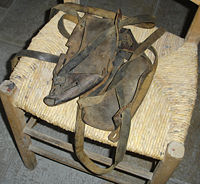
Ciocia
Encyclopedia
Ciocia or zampitto, plural cioce or zampitti, is an ethnic footwear of southern Italy.
 The name probably comes from late Latin soccus, meaning slipper
The name probably comes from late Latin soccus, meaning slipper
. It has many other forms in some Italian dialects like chiochia, chioca, chiochiera, ciocero or scioscio in Neapolitan language
. The terms "ciociari" and "Ciociaria" have a lexical similarity to the noun ciocia, so many historians thought they have their root word in local footwear's name, so ciociari would mean 'people who wear ciocie' .
Italian peasants and shepherds used to wear cioce especially in Lazio, Molise
(province of Isernia
) and Basilicata
, and they were represented since the 18th century in paintings, in poetry and in storiographic works for their typical shoes and for their coloured clothes. In Abruzzo
, Campania
, Calabria
, Gargano
, Etna, Kossovo and Macedonia similar footwears are reported as well.
In the traditional form, ciocie were made of large soles in leather and straps (strènghe or curiòle) with which the leg was tied from the ankle to the knee. Feet were covered by a large napkin (pèzza).


Slipper
A slipper or houseshoe is a semi-closed type of indoor/outdoor shoe, consisting of a sole held to the wearer's foot by a strap running over the toes or instep. Slippers are soft and lightweight compared to other types of footwear. They are mostly made of soft or comforting materials that allow a...
. It has many other forms in some Italian dialects like chiochia, chioca, chiochiera, ciocero or scioscio in Neapolitan language
Neapolitan language
Neapolitan is the language of the city and region of Naples , and Campania. On October 14, 2008 a law by the Region of Campania stated that the Neapolitan language had to be protected....
. The terms "ciociari" and "Ciociaria" have a lexical similarity to the noun ciocia, so many historians thought they have their root word in local footwear's name, so ciociari would mean 'people who wear ciocie
Italian peasants and shepherds used to wear cioce especially in Lazio, Molise
Molise
Molise is a region of Southern Italy, the second smallest of the regions. It was formerly part of the region of Abruzzi e Molise and now a separate entity...
(province of Isernia
Province of Isernia
The Province of Isernia is a province in the Molise region of Italy. Its capital is the city of Isernia....
) and Basilicata
Basilicata
Basilicata , also known as Lucania, is a region in the south of Italy, bordering on Campania to the west, Apulia to the north and east, and Calabria to the south, having one short southwestern coastline on the Tyrrhenian Sea between Campania in the northwest and Calabria in the southwest, and a...
, and they were represented since the 18th century in paintings, in poetry and in storiographic works for their typical shoes and for their coloured clothes. In Abruzzo
Abruzzo
Abruzzo is a region in Italy, its western border lying less than due east of Rome. Abruzzo borders the region of Marche to the north, Lazio to the west and south-west, Molise to the south-east, and the Adriatic Sea to the east...
, Campania
Campania
Campania is a region in southern Italy. The region has a population of around 5.8 million people, making it the second-most-populous region of Italy; its total area of 13,590 km² makes it the most densely populated region in the country...
, Calabria
Calabria
Calabria , in antiquity known as Bruttium, is a region in southern Italy, south of Naples, located at the "toe" of the Italian Peninsula. The capital city of Calabria is Catanzaro....
, Gargano
Gargano
Gargano is a historical and geographical Italian sub-region situated in Apulia, consisting of a wide isolated mountain massif made of highland and several peaks and forming the backbone of the Gargano Promontory projecting into the Adriatic Sea. The high point is Monte Calvo at . Most of the upland...
, Etna, Kossovo and Macedonia similar footwears are reported as well.
In the traditional form, ciocie were made of large soles in leather and straps (strènghe or curiòle) with which the leg was tied from the ankle to the knee. Feet were covered by a large napkin (pèzza).
Pronunciation

- Ciocia - ˈtʃɔːtʃa, in Rome and Northern Latium.
- Chioca - ˈkjɔːka, in Abruzzo and Marche.
- Chiochiera - ˈkjɔːkjera, in Abruzzo.
- Ciòcero - ˈtʃɔːtʃero, in MinturnoMinturnoMinturno is a city and comune in the southern Lazio, Italy, situated on the north west bank of the Liris , with a suburb on the opposite bank c...
area. - Zampìtto - dzamˈpiːtto, in Southern Latium, Colli Albani and MezzogiornoMezzogiornoThe Midday is a wide definition, without any administrative usage, used to indicate the southern half of the Italian state, encompassing the southern section of the continental Italian Peninsula and the two major islands of Sicily and Sardinia, in addition to a large number of minor islands...
.

